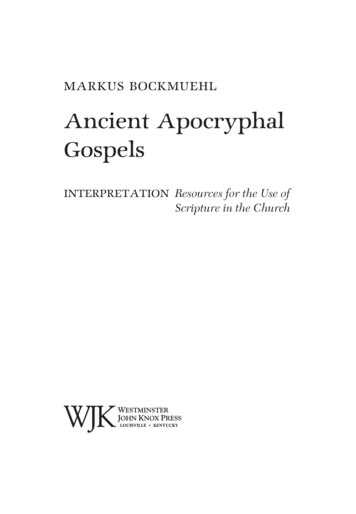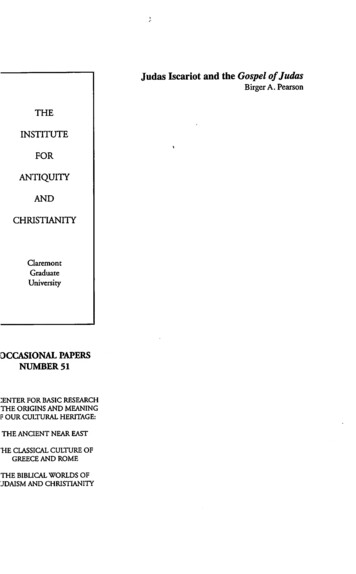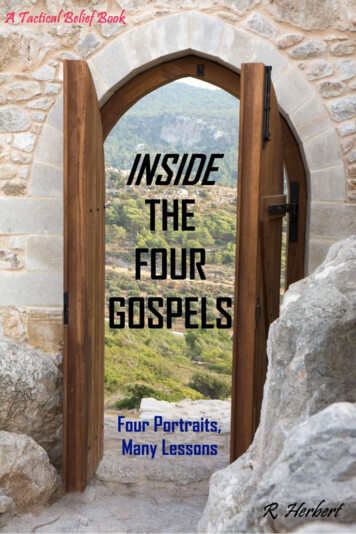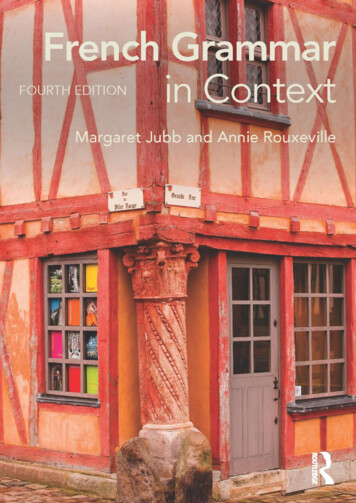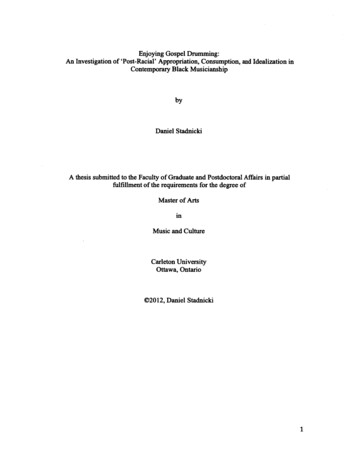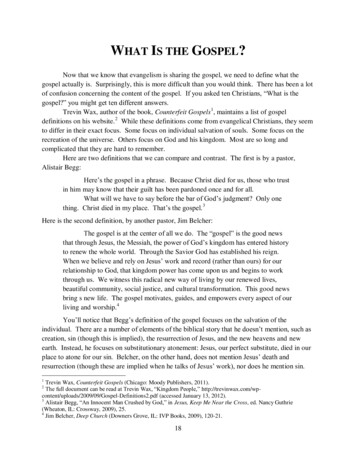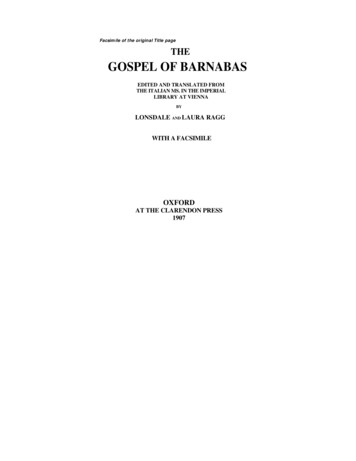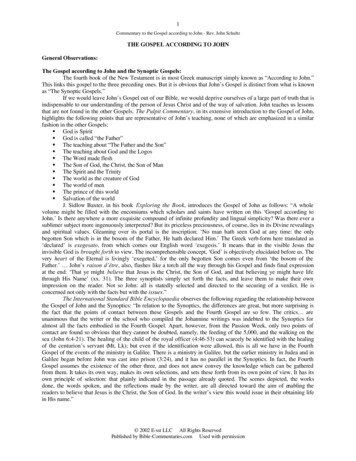
Transcription
In die Skriflig / In Luce VerbiISSN: (Online) 2305-0853, (Print) 1018-6441Page 1 of 7Original ResearchThe gospel in context: Hiebert’s criticalcontextualisation and charismaticmovements in Sierra LeoneAuthor:Joseph B. Bangura1Affiliation:1Faculty of Theology,North-West University,Potchefstroom Campus,South AfricaCorresponding author:Joseph Bangura,jbbangura@gmail.comDates:Received: 12 Nov. 2015Accepted: 04 Apr. 2016Published: 29 Sept. 2016How to cite this article:Bangura, J.B., 2016, ‘Thegospel in context: Hiebert’scritical contextualisation andcharismatic movements inSierra Leone’, In die Skriflig50(1), a2061. http://dx.doi.org/10.4102/ids.v50i1.2061Copyright: 2016. The Authors.Licensee: AOSIS. This workis licensed under theCreative CommonsAttribution License.Read online:Scan this QRcode with yoursmart phone ormobile deviceto read online.This article examines the process of contextualisation adopted by charismatic movements(CMs) in Sierra Leone. In it I use Hiebert’s model of critical contextualisation to evaluate thebiblical depth and cultural sensitivity of the CMs’ contextualisation. Three ongoing culturalissues are especially highlighted as crucial and are used as the point of departure in thediscussions: initiation ceremonies, polygamous marriage practices and ancestral rituals. Thearticle concludes that, whilst the danger of syncretism is likely to occur where uncritical formsof contextualisation are employed, the CMs in Sierra Leone are attempting to address themesthat are concurrent with the African sensibilities of its followers. This is an effort to buildauthentic forms of Christianity that are faithful to Holy Scripture and relevant to the setting inwhich they are developed.Introduction, scope and methodologyTwo hundred years after Christianity arrived in Sierra Leone, the oldest Protestant missionaryfield in West Africa, the country is once again experiencing a revival of the faith (Olson 1969;Shyllon & Anthony 2008). This time, however, indigenous agents rather than foreign missionariesare responsible for the revival and growth of Christianity. This revival is predicated uponcharismatic movements (CMs) whose church-planting efforts that started in the late 1980s arebeginning to have an impact on specific issues in Sierra Leone’s cultures. However, because thereis a wide variety of independent churches, ministries and networks that are often included inmost scholarly definitions of African CMs, it will be proper to put forward a definition thatelucidates the meaning of the term used here to guide the discussion in this article.Any discussion about the rise of CMs in Sierra Leone, as it is the case elsewhere in Africa(Lindhardt 2014:10), requires that a definition and delimitation be put forward to clarify themeaning of the term as used in this article. In the scholarly literature, there are generally twobroad categories that define the term. The first meaning of the CMs refer to the charismatic revivalthat occurred in historic mainline churches and denominations in the 1960s (Hocken 2009:29), themost prominent of which was the Reverend Dennis J. Bennett’s admission at St. Mark’s EpiscopalChurch in Van Nuys, California, that he had experienced the baptism of the Holy Spirit (Bennett1982:82–83). This prompted a flurry of confessions from those who had also received the baptismof the Holy Spirit, but had chosen to remain as communicant members of those historicdenominations (Van der Laan 2010:204; Menzies & Menzies 2000:17). These historic churches thathad been affected by this charismatic renewal are not discussed in this article. A second meaningrefers to independent charismatic churches, ministries and networks that developed outside ofclassical Pentecostalism, or historic missionary and mainline churches from the late 1970s to thepresent. This new development within the African church context has been variously described asneo-Pentecostal, charismatic, and neo-charismatic churches or simply CMs (Anderson 2001:15–20;Anderson 2014:114; Mwaura 2004:96–101; Ojo 2006:1). Following the sense suggested by thissecond definition and given that these new churches, ministries and networks were described asCMs ever since they emerged in Sierra Leone in the 1980s, this article chooses to refer to thesechurches, ministries and networks as CMs.African CMs are known to emphasise divine healing, miracles, demons and exorcism, dreams andtheir interpretation, prophecy, prosperity, anointing with olive oil and differentiating betweenspirits (Asamoah-Gyadu 2013; Clarke 2014). These churches are most active in urban centreswhere they have a large following amongst the educated African élite who feel that the movement’sspirituality makes sense, addresses unresolved questions and enhances the cultural worldview ofhttp://www.indieskriflig.org.zaOpen Access
Page 2 of 7this constituency (Anderson 2014:135). The burgeoning ofCMs in urban centres allow the movement to usecontemporary media technologies to spread its message ofprosperity, healing and spiritual power to a much wideraudience. These charismatic churches appear to be addressingthemes that are concurrent with the African culturalsensibilities of its urban élite and youthful followers. Whilstthe cultural themes are themselves not new, the responsesoffered by key leaders of the movement are certainly new.This does not surprise us because the growth of Christianityin the southern hemisphere implies that ‘ what is to beexpected from the South is a theology that addresses thesetting in which it is produced’ (Walls 1996:9–10).Given that charismatics are the most enthusiastic Christianson the African continent (Anderson 2004:159; Hylson-Smith2007:139), and bearing in mind that these ‘ rising churchesusually preach a strong and even pristine Christian message’(Jenkins 2002:126), researchers are beginning to take interestin the theological practices of the movement. Amongst othertheological markers, African charismatics employ exuberantand highly engaging sessions of praise and worship, completewith live bands and loud music (Kalu 2008:263). Duringworship services, church members use the name of Jesus tobind and cast out demonic forces and evil spirits that mightwant to obstruct spiritual and material prosperity and denymembers the healing they so desperately desire (Freeman2012:13). Charismatics are described as Bible-believing andHoly Ghost-anointed churches ‘ who do not compromiseon the divinity and sacredness of the Bible’ (Asamoah-Gyadu2013:166). Bible reading functions as a repository of narrativesthat impacts directly on the life of the individual believer(Gifford 2005:86). Church members are often anointed withconsecrated olive oil which is said to enhance their abilityto display exceptional spiritual power. This anointingcapacitates them so that they are able to ward off attacksfrom the devil and his legion of demons. It is also said to givethem victory in spiritual warfare. Followers of these newChristian movements believe that there are spiritual causesfor every physical occurrence in life (John 1997:131). Thisfaith recognises the abstruse presence of demonic forceswhose intent is to hamper human flourishing (Van der Meer2010:158). The popularity of Charismatic theological practicessuggest that there were historically unresolved questionswithin the churches that are now been addressed bycharismatic churches (John 1997:134).As Christianity continues to grow in Africa, new missiologicalquestions arise about how to apply the Christian faith to theexisting cultural issues. These questions are meant to enablethe African church to become faithful to biblical Christianityand relevant to the local cultural context in which the faith isexpressed. In Sierra Leone, CMs are attempting to interpretafresh the relationship they believe should exist between thegospel and traditional cultures (Bangura 2013:163). However,this charismatic attempt to relate Christianity to culture hasnot been subjected to scholarly research, although manyChristians subscribe to the core doctrines of spiritual power,http://www.indieskriflig.org.zaOriginal Researchdeliverance from demonic oppression and prosperityespoused by the movement.As a consequence, the scope of the article is to examinethe critical contextualisation adopted by CMs in Sierra Leone.I do this in three ways. Firstly, I examine Paul Hiebert’smodel of critical contextualisation as a viable tool forunderstanding the process of contextualising the gospel.Secondly, I profile three crucial issues (initiation ceremonies,marriage practices and ancestral rituals) in Sierra Leone’scultures that continue to impact church ministry. Thirdly,using Hiebert’s model of critical contextualisation, I discussthe reasons why charismatics believe that their attempts atcontextualising the gospel are proving useful for the churchand pastoral ministry context in Sierra Leone.In terms of methodology, this article grew out of my 2013doctoral dissertation, a study which was based on amissiological analysis of the CMs in Sierra Leone. In itI analyse Hiebert’s model of critical contextualisation indialogue with the contextualisation and church ministrycontexts of CMs in Sierra Leone. As part of this endeavour,I undertook three field research trips to Sierra Leone whereinterviews with key leaders of the movement were conducted.This process gave me unhindered access to material andbooks published by the leading advocates of the movementswhich were used to evaluate the CMs’ contextualisation(Cole 1999; Laggah 2003; Mambu 2011).Critical contextualisationContextualisation has been an ongoing theme in missiologicaldiscourse. When the term first emerged in the 1960s from itsancestry in the conciliar movement (Hesselgrave & Rommen1989:27–35), it was suggested as better suited to correctthe limitations created by the inability of Western theologyto understand the cultures and contexts of non-Westernchurches and thus leverage the drawback of earliermodels such as inculturation, enculturation, translation andindigenisation, amongst others (Magesa 2004; Sanneh 1989;Schineller 1990). More than this was the admission thatcontextualisation took provenance over other models becauseof its inability to respond to the social and cultural changesthat have occurred in the African or Latin American missionfields (Bevans 2002:26–27). Contextualisation refers to anongoing process where the gospel is assimilated into the totallife of the people in their cultural context so that the messagemakes sense to those who profess it (Bosch 1983:495;Flemming 2005:13–14; Bevans 2002; Whiteman 1997). For thisprocess of contextualisation to be effective, it has to ensurethat it guards against leading the Church away from biblicaltruth by facilitating the emergence of a form of Christianitythat makes sense to people. However, in doing this, thedanger of syncretism is likely to occur, especially if the extentto which the church can contextualise the gospel has not beenclearly identified (Greenfield & Droogers 2001).Although contextualisation is an ongoing theme inmissiology, little effort has been made to apply specificOpen Access
Page 3 of 7models of contextualisation to the church contexts of CMs inWest Africa. Mindful of the risk of oversimplification, thespecific experiences of charismatics in Sierra Leone make thisstatement much more justifiable. Whilst CMs have movedfrom an initial peripheral position to become a major factorthat determines the course of Christianity in Sierra Leone, asit is in much of sub-Saharan Africa (Lindhardt 2014:1), littleresearch has been carried out that shed light on thischarismatic resurgence of the Christian faith, or its efforts tocontextualise the gospel.In Sierra Leone, it is only John (1997:129–137) who attemptedto situate the role played by charismatics as they seek tofoster community and cohesion within the group in a chapteron ‘Charismatics and Community’. Even Shyllon (2008:234),Sierra Leone’s leading Church historian, only mentions themovement in passing, adding that it is known to be embroiledin feuds that often lead to splinters and schisms, as well asbeing accused of involvement in proselytising and sheepstealing from mainline denominations. Although insightful,these studies are bereft of answers to questions of history andcontextual theological practices of the movement. It is thisabsence of critical missiological research on the charismaticchurches in Sierra Leone that inspired me to attempt torespond to the problem of the movement’s contextualisation.It was Paul Hiebert who introduced the model of ‘criticalcontextualization’ to missiology. Hiebert (1984) affirms that asthe gospel advances to foreign geographic territories, newmethods are bound to arise that help the church to effectivelycontextualise the gospel. In this model, Hiebert notes that thegrowth of the church in new cultural contexts always raiseschallenges for the gospel. This model, Hiebert submits, guardsagainst the ethnocentricism and cultural foreignness thatnon-contextualisation creates and it prevents newly foundedchurches from relapsing into relativism and syncretism whenextreme forms of contextualisation are uncritically adopted(Hiebert 1987:109). As Hiebert reminds us, ‘ the gospel isnot simply information to be communicated. It is a message towhich people must respond’ (Hiebert 1987:110). Those whocome to faith in Christ are expected to live in the light of theirnewly found faith. This may require that converts sever oldties, adapt old ways to new contexts or make a permanent andcomplete break with past traditions altogether. The Christianmissionary therefore has to exercise great caution whilstcommunicating this message and inviting people to faith inJesus Christ.By guarding against these two extremes (ethnocentricismand cultural foreignness) that often challenge contextualisation,Hiebert’s model offers four steps that the church can take toincarnate the gospel in its new cultural context. These are:exegesis of the culture; exegesis of the scripture and thehermeneutical bridge; critical response; and the developmentof new contextualised practices (Hiebert 1987:109–112). Thesesteps require the total participation of African converts withthe missionary, as new converts study their culture in light ofscripture to build up the faith in a manner that is grounded inhttp://www.indieskriflig.org.zaOriginal Researchand faithful to the Bible (Clarke 2014:29–34; Asamoah-Gyadu2013:166; Anderson 2014:63).Cultural practices in Sierra LeoneThe Republic of Sierra Leone, situated in West Africa has apopulation of 7 million. Sierra Leoneans are a deeply religiouspeople (Featherstone 2015:1). Although precise statisticsabout the religious percentage share are hard to come by,estimates indicate that between 40% to 60% of the populationare Muslims and 30% to 40% follow various versions ofAfrican traditional beliefs. The remaining 15% to 20% identifythemselves as Christians, with about 7% subscribing to newercharismatic and Pentecostal beliefs (Pew Research Centre2015:242). The variability in the figures is an indication of thelevel of inter-religious tolerance and peaceful coexistencepeople enjoy in the country (Featherstone 2015:18). In spite ofthe lower percentage of Christians, the country’s historic rolein the spread of Christianity is impeccable. As a former crowncolony for British rule in West Africa, Sierra Leone’s Kriopeople played a pivotal role in the early diffusion ofChristianity across West Africa (Sanneh 1983:73; Walls1996:103–104; Hanciles 2002:13; Hastings 1979:40). Today,whilst Christianity is reinventing itself with the foundingand development of independent churches, ministries andnetworks that clearly espouse pneumatic tendencies, culturecontinues to be a hindrance to the authentic experience of theChristian faith.Sierra Leone’s 14 ethnic groups practise cultures that havesimilar characteristics. These cultures define acceptabletraditions and norms that its people are expected to follow.They lend credence to the identity of persons and demarcatetheir place in the wider community. Because these traditionalpractices preceded the advent of Christianity and Islam inSierra Leone, when people convert to Christianity, theirpersonal or communal experiences as Christians are normallyassessed against their cultural backgrounds (Kruetzinger1966). It is, therefore, necessary that these cultures andtraditions are subjected to careful analysis so that we canbetter understand the CMs’ contextualisation. Three of themost pervasive cultural practices are discussed below.Initiation ceremoniesAmongst the Temne ethnic group of northern Sierra Leone,the age of puberty signifies the occasion when initiation ritesare performed. These rites which take place at a secret societybush, include the rite of male circumcision and femalegenital mutilation (FGM) (Fanthrope 2007:1–2). Given thecontroversy over this cultural practice, I shall focus brieflyon the female Bondo secret society where FGM is performed(Schimmel 2007). At puberty, young girls are sent to thedigba, a revered female traditional leader who also doublesas a traditional midwife, to go through genital cutting.Working with trusted female traditional elders, the digbareceives the bora (financial token) from the parents of theyoung girls through the chiefdom elders. She prepares thegirls for initiation rites, performs the cutting of the labiaOpen Access
Page 4 of 7minora and supervises every stage of the initiation ceremony(MacCormark 1979:32). The new initiates, who are kept inisolation throughout the process, are only presented backto the community upon the successful completion of allinitiation rites. When enacting her roles, the digba serves asthe official representative of the community of elders, whichcomprises the living and ancestors. The entire initiationceremony is intended to train young initiates to developkinship ties with age mates, identify their place within thecommunity and acquire skills that will help them tomeaningfully participate in the cohesion of the communityas responsible adults. It is the responsibility of the digba toimbibe in the young girls the skills necessary for serviceas elder sisters, wives, and mothers. Unless young girlscomplete initiation ceremonies of the Bondo secret society,they will not be married off or perceived as responsibleadults (Davies 2009). Non-initiates are often subjected toridicule and ostracisation by peers.Marriage patternsSierra Leoneans share a deep sense of allegiance to theirfamily. Family life includes more than father, mother andchildren. The belief amongst them is that human life shouldnot be lived outside of the community. A life lived in seclusionis unthinkable. In any given single home, there would be atleast three generations of people present – grandparents,parents, and children. The family unit can best be describedas an extended family, rather than a nuclear family(Featherstone 2015:1). In such circumstances, the practice ofpolygamy is a traditionally accepted norm that governsfamily and community life. Although this practice is muchmore prevalent amongst people living in the traditionallyconservative rural regions of Sierra Leone, those who migrateto settle in urban centres still have the inclination to continuethis tradition. The 2004 National Population Census indicatesthat 18.31% of the national population is living in polygamoushouseholds (Thomas, MacComock & Bangura 2007:7).Amongst the Temne, Mende and Limba people, polygamyaccords men the right to marry many wives. There are nolimits that are imposed on the number of wives the husbandis allowed to have, as long as he is able to pay the dowry.There are a number of reasons that lead to polygamy.Prominent amongst the reasons why the practice of polygamyis allowed is procreation. Amongst the Temne, althoughfamilies need to grow in number, childbearing is not allowedoutside marriage. If after contracting a marriage, the wifefails to bear children, tradition allows the husband inconsultation with his family along with the first wife, to lookfor a second wife. The second wife is usually expected to bearchildren for that family. The search for the co-wife is carriedout from the same clan, village or region where the husbandoriginated. All the traditional rights that go with marriagesare performed fully for the second wife. Other reasons forthe prevalence of polygamy may include agriculturalproductivity, the right to become a member of a traditionalruling family or even for purely personal reasons. Newadvocates for the continuation of traditional marriagepractices emerge with an ever increasing frequency.http://www.indieskriflig.org.zaOriginal ResearchAncestral ritualsAncestors play an important role in the traditional worldview of Sierra Leone. The belief that ancestors continue toexist after death in the world of the ‘living dead’ remains anintegral part of what sustains the well-being of thecommunity (Sawyerr 1966:30). The ancestors are the rockfrom which the present generation is hewn. Therefore, theywield enormous influence on their surviving relatives, somuch so that it is well nigh impossible to set them aside. Todo this will be equivalent to depleting that community of itsroots in the past, denying its culture and smearing its dignity(Conteh 2009:37). This view of the ancestors held by SierraLeone’s traditionalists points to two rites that must beupheld if surviving relatives desire to continue enjoying theprotection, provision and good will of the ancestors (Foullah2000:73). Traditionally, death does not end human life.Death is transitory, possessing the power to usher personsfrom a state of physical existence to one that is spiritual.Although the dead are believed to be spatially living in theabode of their graves, they continue to exist as real spiritualbeings in the world of the living dead. That is why peoplewho hold to this traditional world view have a clear sense ofa place where they believe the ancestors presently live. TheKrio for instance, believe that at death the ancestors proceedfrom physical existence to live in the ‘world of truth.’ Herethey do not suffer from the corrupting effects of deceptionwhich blight human societies because they now knowreality (Sawyerr 1966:43). The Mende believe that their deadare ‘living in God’s bosom’ (Yambasu 2002:64). Both theLimba and Temne believe that the ancestors ‘live in theplace of the dead’ (Conteh 2009:38–39). This abode does notsuggest any inability to act, but from this place of the dead,the ancestors are better able to monitor, control and/orchange the course of events amongst their living relatives.Thus, ancestors are always consulted when important lifeevents are celebrated.Charismatics, culture and criticalcontextualisationSierra Leoneans are fascinated with continuing certaincultural practices even after conversion (Davies 2009:1). Thisgrip that culture has on the world view of persons oftenchallenges the Church’s missionary approach and itsunderstanding of the faith. Whilst the Church has notprojected an unanimous approach to the issue of culture,charismatics are gradually becoming noticeable for theirresponse to specific issues in culture. Bishop Julius Laggah,prelate of Bethel World Outreach Ministries Internationalfounded in 1992, believes that every human culture has arepertoire of good aspects and values. He argues further, likemany other leaders of the CMs, that the entry of sin intocreation distorted those good values and opened them up todemonic influences. Demonic cultures prevent people fromcoming to faith in Christ. These corrupted human cultures,he argues, must be evangelised and resubmitted to Christwhose redeeming power brings about transformation. Usingthe passage from Revelation 7:9 where John saw the greatOpen Access
Page 5 of 7multitude from every nation, tribe, people and language,Laggah (2003) adds:The gospel that we are called to preach should transcend culturaland ethnic barriers God is interested in the salvation of everyculture whether it be African, European, American or Asianculture. (p. 47)As a consequence, Laggah calls on the churches to beextremely careful in the process of contextualisation to avoidthe danger of bringing sinful aspects of traditional cultures,such as initiation ceremonies, polygamy and ancestral rituals,back into the Church.Charismatics and initiation ceremoniesCharismatics reject participation in all initiation ceremonies,such as the Bondo secret society where FGM is performed. Inhis rebuttal of initiation ceremonies, Bishop Jonathan Cole,who founded New Life Ministries International in 1993,reasons that the female Bondo secret society allows peopleto contract blood covenants with demonic forces. Cole(1999:16–17) sees the Bondo secret society as shrouded inmystery, and argues that the FGM procedure clearlycontradicts the teaching of Holy Scripture. Whilst the Bondosecret society may have contributed to the moral developmentand preparation of young girls so that they are able toperform adult roles, charismatic church leaders such asPastor Francis Mambu, who founded Faith Healing BibleChurch in 1987, believes that the Church has a betteralternative for the training of the young. They do this duringtheir annual conferences where special teaching sessions areheld on marriage and family life (Mambu 2011:52–58).Charismatics, furthermore, have not hidden their antipathyagainst attempts made elsewhere in Africa to Christianiseinitiation ceremonies, the practice of FGM or the entirefemale Bondo secret society (Schfroth 2009). The antidote tothis charismatic aversion to female initiation ceremonies isan intensification of Christian discipleship and Bible trainingin their churches on topics such as marriage and family lifeand Christian parenting.Charismatics and marriage practicesAs noted already, the accepted traditional patterns ofmarriage and family life are polygamous and extended innature. The reasons for this are not farfetched because in asociety where life is lived in dialogue with others, peopleexist not as individuals but in collaboration with each otherin the community. Nonetheless, in spite of this traditionalview on marriage and family life, when the charismaticchurches came into the limelight, leaders of the movementshowed a very critical and vocal attitude against the practiceof polygamy. New Life’s Bishop Jonathan Cole (1999:37),using what he describes as the ‘law of first mention’ which hedevelops from the Genesis creation narrative, argues againstpolygamy as a complete breach of God’s desire for theinstitution of marriage. For him, monogamy is God’s divinewill for the institution of marriage. For Pastor FrancisMambu’s Faith Healing Bible Church, marriage is a holyhttp://www.indieskriflig.org.zaOriginal Researchunion between one man and one woman. Divorced personsare not allowed to re-marry, nor can believers marryunbelievers (Mambu 2011:25–26).To build a cohesive community within their churches,charismatics have supported young couples by paying forsome of their wedding costs. This emphasis has not onlyrestored ethical civility amongst charismatic married couples,but has also provided paradigms of how to live in the midstof the difficult economic times in Sierra Leone. The impact ofthis charismatic preference for monogamous marriage andfamily life, and the support they give to families has broughta number of benefits to the young born-again urban élites,towards whom its ministries are targeted. Firstly, youngcouples are better able to exercise control over their finances.Secondly, it has also led to the restoration of the dignity ofwomen in what used to be a traditional male-dominatedsociety. And thirdly, as John (1997:135) puts it, ‘ women arenot abused by their men, and they do not compete with otherwomen (particularly the in-laws) for the affection of theirhusbands.’Charismatics and ancestral ritualsWhilst charismatics agree that the memory of the dead is tobe cherished, and although the movement has ensured thatwelfare funds (such as the death benefit fund) are created tosupport families when death occurs, they have also beenclear in expressing complete repugnance for specific ancestralrituals (John 1997:135–136). From their reading of HolyScripture, African charismatics like other Christians in Africa,argue that the believer is not allowed to offer animal sacrificesor bring libation to the ancestors (Dt 26:14). This is because byhis death and resurrection, Jesus Christ has offered theperfect sacrifice that has atoned for human sin (Heb 9:26).This recognition means that charismatics believe that there isno other person or spirit who qualifies as intermediarybetween God and his people, other than Jesus Christ.Furthermore, charismatics believe that the Bible stronglyprohibits contacting the dead by invoking their spirits andseeking counsel from them (Dt 18:10–11). Although somehard line traditionalists have accused charismatics offragmenting traditional values by this strict stance againstrituals like ancestral sacrifices, the movement is neitherperturbed nor deterred in its resolve to remain faithful to thescriptures (John 1997:136).Hiebert’s critical contextualisationHaving examined the charismatic responses to Sierra Leone’songoing cultural issues, is there a basis on which thesecharismatic contextualised practices can be applied to themodel proposed by Hiebert’s? Four perspectives will helpshed light on the link between them.Firstly, Hiebert contends that this model seriously regardsthe efficacy of the gospel and the essential nature of humancultures in understanding the gospel. To allow this to happenin a specific mission context, an exegesis of both culture andOpen Access
Page 6 of 7the scriptures is required. African charismatics like otherChristian groups, take Holy Scripture seriously and wants tocommunicate in ways that are just and fair to the recipientculture (Lindh
Church in Van Nuys, California, that he had experienced the baptism of the Holy Spirit (Bennett 1982:82–83). This prompted a flurry of confessions from those who had also received the baptism of the Holy Spirit, but had chosen to remain as communicant members of those historic denominations (Van
